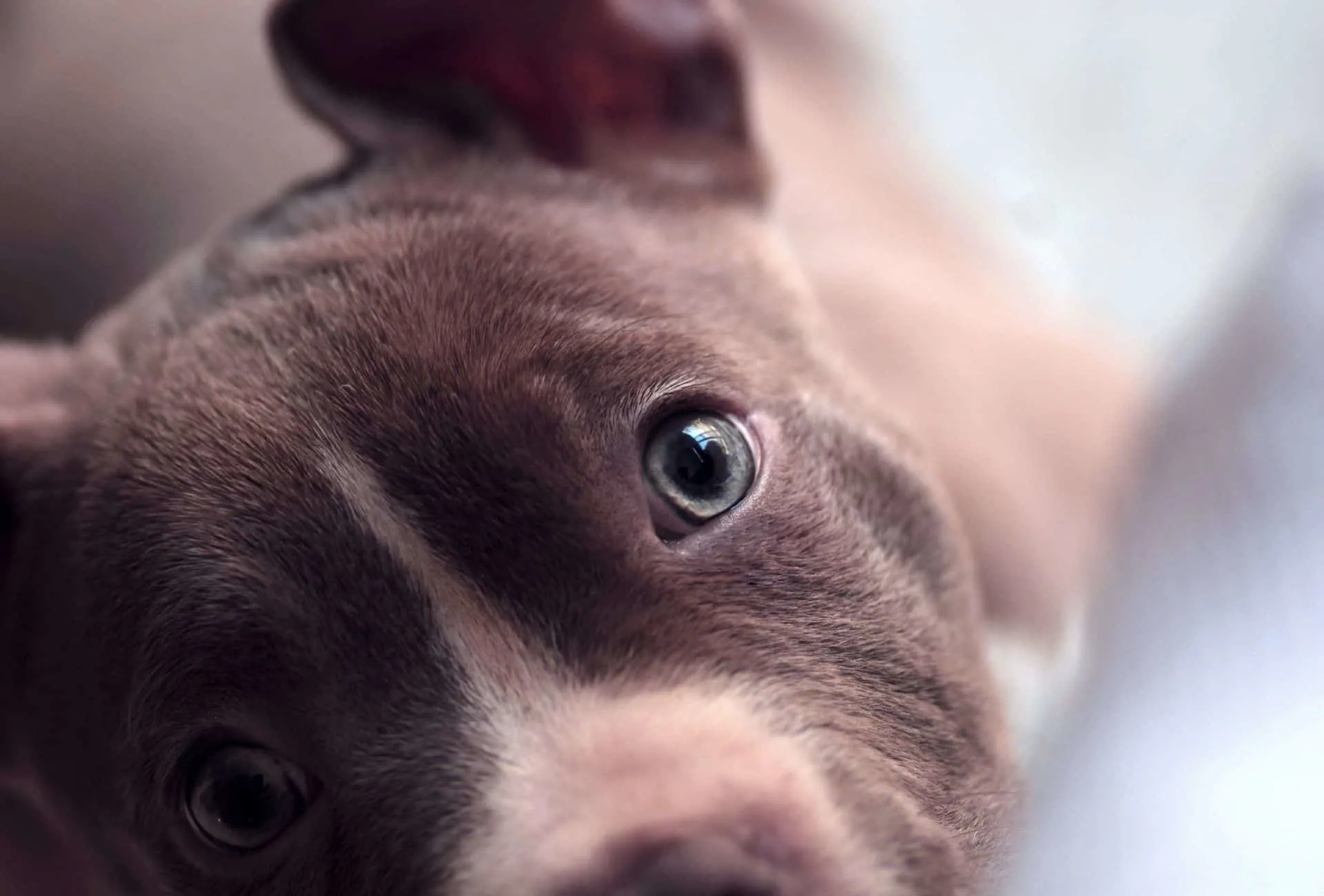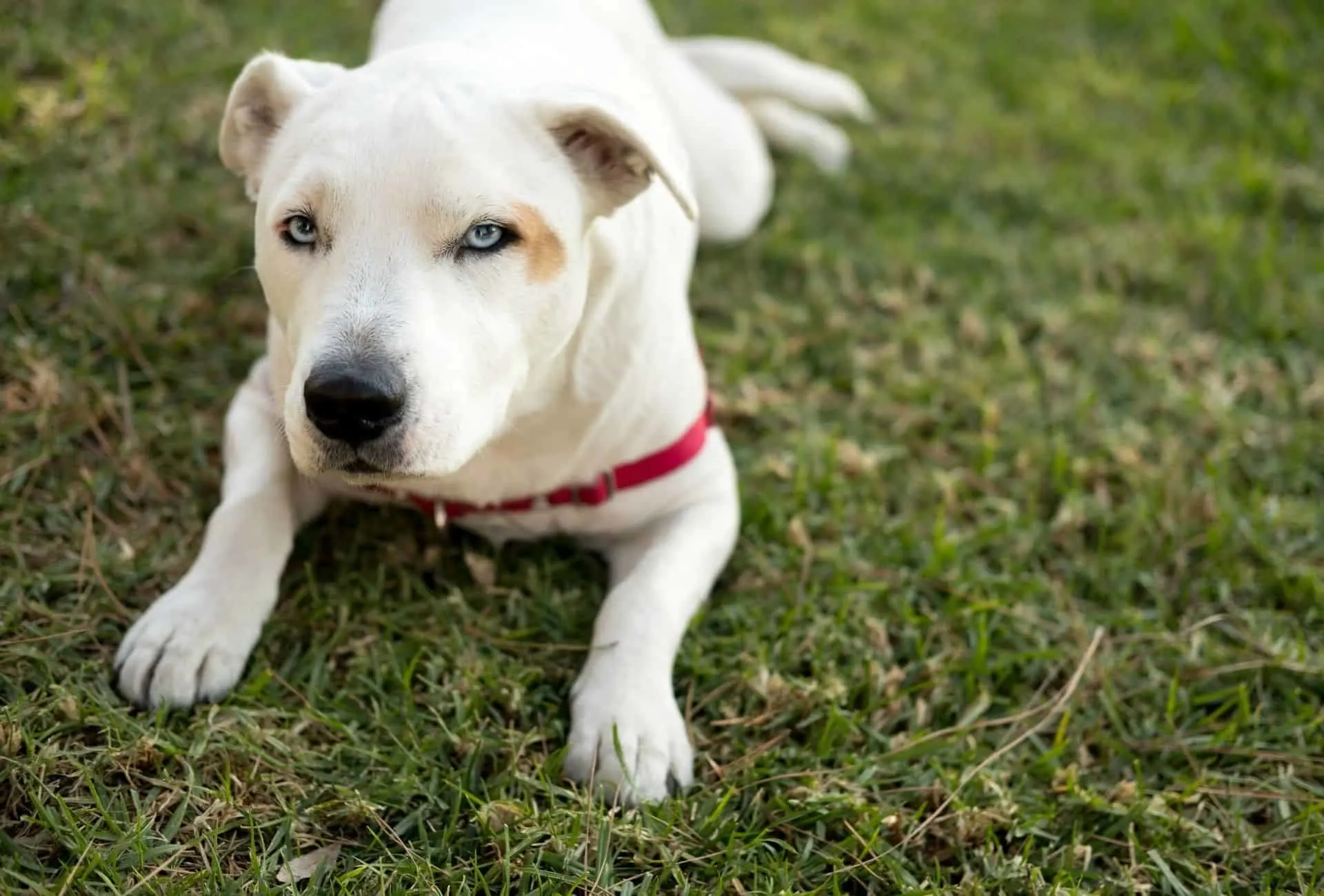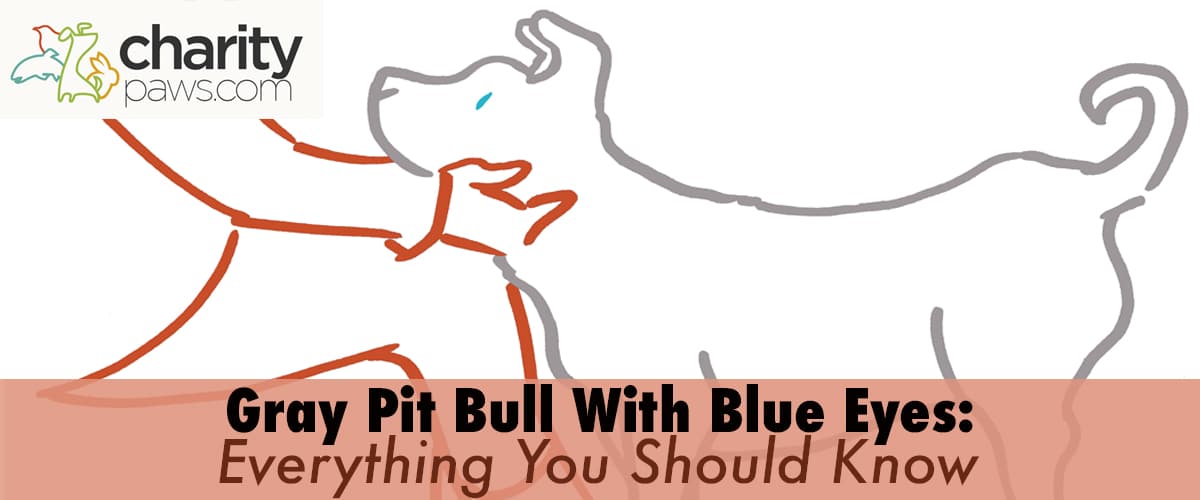Blue eyes seem to be the color that everyone loves in dogs.
This is especially true of the grey pitbull with blue eyes.
When I see a rescue with a litter of pitties with gray fur and blue-eyes there is usually a line of adopters waiting to scoop one up.
Yes, that is great news for the pups – but this can lead to people caring more about looks than temperament which in the long run can pose problems.
So, let’s talk about grey pit bull dogs.
But is it a weird genetic trait that makes their eyes blue, or is it in fact a normal trait that some bullies have.
What Is A Pit Bull?

I am assuming you are already familiar with the pit bull breed since you are here, but I want to do a quick review of what is considered a pit bull.
You may not know that a pit bull in itself is not a breed. It is more of a category of a dogs that have similar features that typically include big heads and lots of muscles.
The breeds that are typically labeled “pit bulls” are:
- American Pit Bull Terrier – which my foster fail Cleo is!
- Staffordshire Bully Terrier
- American Bully
- American Staffordshire Terrier
Can A Pit Bull Have Blue Eyes?
Yes, pit bull breed dogs can have blue eyes, but usually only as puppies.
Some may keep those baby blues into adulthood, but that is rare.
Just like people are born with blue eyes, but they darken, the same applies to dogs.
Color, like everything, is determined by the genetic makeup and developed by the amount of melanin production in your dog.
Melanin is a natural skin pigment that determines how light or dark your skin, hair and eyes are.
Less melanin production leads to lighter blue eyes, pale skin or blonde hair.
A complete lack of pigmentation is called Albinism.
In dogs, this low production of melanin can cause a white coat, blue eyes or a pink nose.
Melanin production only starts a few weeks after birth and slowly increases with age.
That’s why most puppies are born with bright blue eyes and a lighter coat.

The coat color oftentimes influences the eye, nail and nose color.
My Rottweiler, for example, has so much melanin in her fur that blue eyes would be nearly impossible.
How Long Do Pitbull Puppy Eyes Stay Blue?
You may get a first glimpse at your Pitbull’s adult eye color around the age of 4 months.
Their puppy coat will be replaced by a much thicker and darker adult coat when they are 6 months old.
Are Blue-Eyed Pitbulls Rare?
Blue-eyed Pitbull puppies are not rare and their eye color will most likely change over time.
So don’t choose the one bright-eyed Pitbull in the litter just because of his appearance.
Even if a breeder sells them as “rarity” for a premium, the color will almost certainly vanish (if it’s a purebred, more on that below).
That being said, while blue eyes are not particularly rare for Pitbull puppies, not every pup has blue eyes.
Breeding For Blue Eyes
We are not fans of breeding dogs for sale as a whole, but breeding for specific genetic traits bring up a whole new batch of potential issues.
The problem with breeding for specific traits is that often the breeder will disregard more important factors like a dog’s health.
This can turn into a medical nightmare for potential adopters (or buyers) of the dog.
There is also the scenario where a breeder will allow parents and children to breed, which is called inbreeding.
This can lead to horrific health issues.
While you may be interested in finding a breeder that will create a blue-eyed pup for you, we highly suggest you do not go that route.
Even AKC breeders who do not do this kind of breeding have tons of problems with healthy dogs.
Can you imagine the disaster of trying to create a dog with certain traits?
The Merle Gene
Merle describes a beautiful coat color pattern that can create odd-colored eyes.
It’s commonly seen in these breeds:
- Australian Shepherd
- Great Dane
- Dachshund
- Catahoula Leopard Dog
The merle gene sadly comes with many health issues like deafness and blindness.
Double merles (MM) are extremely prone to these genetic diseases and therefore merles should never be bred together.
Heterozygous merles (Mm) are healthier and resemble the merle pattern best.
A Pit Bull with a merle coat pattern is excluded from the APBT breed standard and might not be purebred because the gene must have somehow found its way into the bloodline.
Albinism
Tyrosinase is an enzyme that controls the production of melanin. Albino dogs are “tyrosinase-negative” meaning that their body is incapable of producing melanin.
Therefore, these dogs will be born with a unique white coat, blue eyes and a pink nose.
Albinism in dogs is an extremely rare mutation and both parents need to carry the recessive gene.
Be very cautious when a breeder is trying to sell you a rare white pitbull.
Albinism comes with many health issues, including deafness or skin cancer.
Due to their pale coat, they must be protected from direct sunlight at all times using either bodysuits or sunscreen.

White Fur Patches
White patches around the eyes or nose can occur due to a lack of pigmentation.
Pit Bulls or any other breed with dominant white coats can develop light eyes or a pinkish nose.
Do Blue Eyed Dogs Go Blind?
Dogs with blue eyes are not necessarily doomed to develop any vision-related issues.
It largely depends on the specific reason your dog might have this eye color.
Pit Bulls are not among the breeds that carry this breed-specific gene, meaning that they probably will develop health problems later on.
You should stay away from the merle gene and albinism.
If you find a responsible breeder that has legitimate puppies with blue eyes, there is probably nothing you need to worry about as the color will start transforming at the age of 4 months.
What Dog Breeds Commonly Have Blue Eyes?
While pit bull breed dogs are not genetically inclined to have blue eyes, there are several breeds that do.
If blue eyes are high on your list of wants in a dog, then consider adopting one of these breeds:
- Siberian Husky
- Border Collie
- Catahoula Leopard Dog
- Dalmatians (nearly 1/3 suffer from hearing impairment)
- Australian Shepherd (due to undesirable Merle gene)
Final Thoughts

Now that you know it is not common for adult dogs to have blue eyes, finding a pit bull puppy with blue eyes does not mean they will keep that eye color.
Eye, coat, nose and skin color of any mammal is determined by the production of melanin.
Lack of pigmentation can lead to blue eyes, a white coat and a pink nose.
Adult Pitbull-type dogs with blue eyes are extremely uncommon and should only be considered with detailed health certificates of the parents stating that they don’t carry the merle gene.
Blue-eyed puppies are very common among many breeds and adorable to look at.
If you are in love with the appearance of blue eyes and can’t live without it then consider breeds without any health issues indicated by eye color like the Siberian Husky (make sure they fit your lifestyle and level of knowledge).

